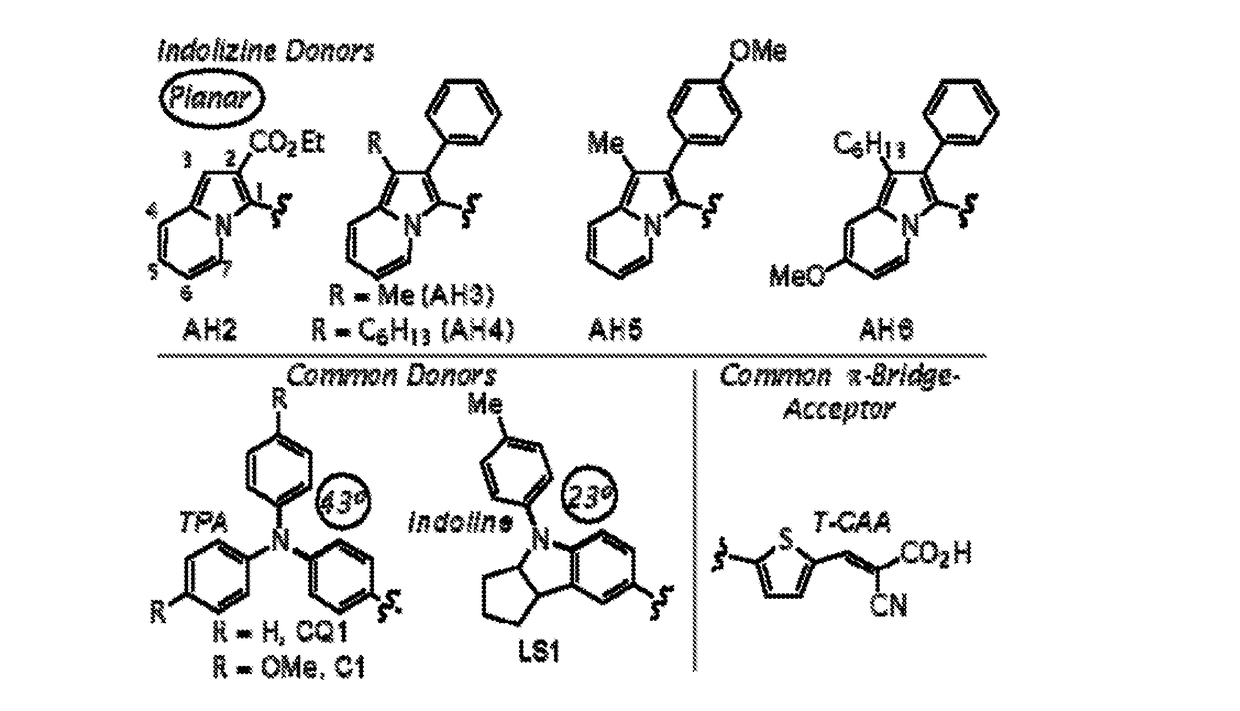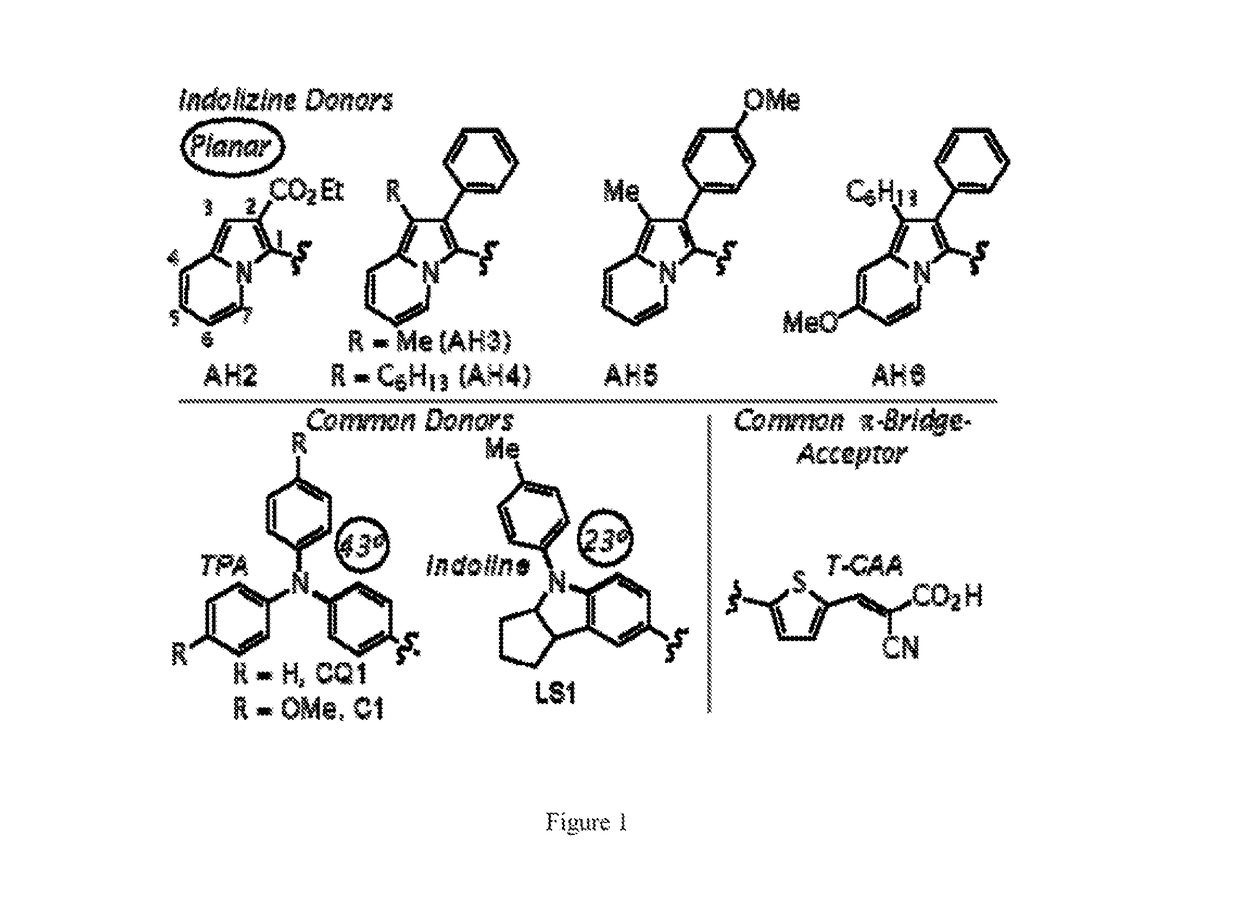Indolizine-based dyes for dye-sensitized solar cell
a solar cell and sensitizer technology, applied in the field of indolizine-based sensitizers for use in dye-sensitive solar cells, can solve the problems of non-functional dyes, unsatisfactory donor systems, and non-optimal nitrogen lone-pair orbital alignment, and achieve high solar-to-electric power conversion efficiencies (pces), relative affordability, and cost-effective
- Summary
- Abstract
- Description
- Claims
- Application Information
AI Technical Summary
Benefits of technology
Problems solved by technology
Method used
Image
Examples
example 1
[0067]This Example describes the synthesis and characterization of embodiments of sensitizers in accordance with embodiments of the presently-disclosed subject matter. See FIG. 1. The selected DSC target indolizine-based dyes keep the π-bridge and acceptor regions constant as thiophene-cyanoacrylic acid (T-CAA) throughout the series for simple donor effect comparison (FIG. 1). The indolizine donors differ in electron-donating group (EDG) strength at the 2-position, substituent choice on the 6-member ring at the 5-position, and in varying alkyl chain length at the 3-position. For practical synthetic purposes, we found the 2-position may be substituted with either electron-withdrawing functionality (which adversely effects charge transfer based absorptions) or with aryl substituents to yield air-stable electron-rich intermediates.
[0068]The synthetic route employed for all dyes began with donor formation followed by palladium-catalyzed direct C—H arylation at the indolizine 2-position,...
example 2
[0069]This example demonstrates optical and electrochemical properties for near infrared compounds of the present invention.
[0070]The optical properties of AH2-AH6 were analyzed to understand the effect of the indolizine substituents on the UV-Vis absorption properties (see Table 1, below, and FIG. 2).
TABLE 1Optical and electrochemical properties ofAH2-AH6 in dichloromethane solutions.λmaxλonsetεEgoptE(S+ / S)E(S+ / S*)dye[nm]a)[nm]a)[M−1cm−1]a)[eV]b)[V]c)[V]d)AH24195351,2502.321.22−1.10(sh)AH35536338,5001.960.99−0.97AH455863311,3001.960.99−0.97AH55626405,8001.940.97−0.97(sh)AH659267512,5001.840.85−0.99CQ1e)44254025,0002.301.16−1.14C1f)49959027,5002.10 1.04g)−1.06LS1h)52360020,0002.071.01−1.06a) Measured in CH2Cl2 and 0.5% AcOH.b) Estimated from the intercept of an absorption curve tangent line intercept with the baseline on the low energy side of the maximum absorption curve in CH2Cl2. Conversion from nanometers to eV was calculted by Egopt = 1240 / λonset. E(0-0) for dyes (for which em...
example 3
[0075]For dyes to efficiently inject electrons into the TiO2 conduction band with minimal back electron transfer from TiO2 to the oxidized dye, the LUMO should be positioned near the dye anchor and significantly separated from the dye HOMO. To examine the orbital geometries, AH3-AH6 were computationally evaluated using a variety of density functional theory (DFT) methods (B3LYP, VSXC, MN12L, N12, M11L, VSXC, M06L, LC-PBE, PBE0, CAM-B3LYP) and basis sets (6-31G(d,p), 6-311G(2df,2pd)) in vacuum and in dichloromethane polar continuum model (PCM). The HOMO and LUMO orbitals for each of the dyes show the HOMO primarily localized on the indolizine donor and the LUMO primarily localized on the T-CAA motif (FIG. 4). The dye LUMO and HOMO orbital arrangements are well situated for efficient electron injection from the dye into the TiO2 conduction band and diminished back electron transfer from the TiO2 semiconductor to the oxidized dye, respectively.
[0076]A tremendous number of organic dye b...
PUM
| Property | Measurement | Unit |
|---|---|---|
| dihedral angle | aaaaa | aaaaa |
| dihedral angle | aaaaa | aaaaa |
| absorption wavelengths | aaaaa | aaaaa |
Abstract
Description
Claims
Application Information
 Login to view more
Login to view more - R&D Engineer
- R&D Manager
- IP Professional
- Industry Leading Data Capabilities
- Powerful AI technology
- Patent DNA Extraction
Browse by: Latest US Patents, China's latest patents, Technical Efficacy Thesaurus, Application Domain, Technology Topic.
© 2024 PatSnap. All rights reserved.Legal|Privacy policy|Modern Slavery Act Transparency Statement|Sitemap



